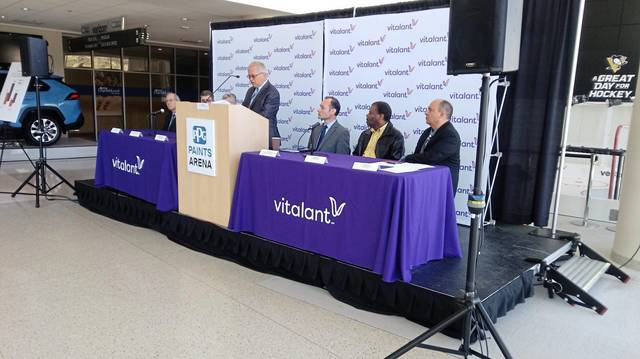Western Pa. blood donors dropped by half during last decade
Share this post:
The Pittsburgh area is experiencing a dramatic decline in blood donations, and health care professionals are alarmed.
The number of blood donors in the region has been nearly cut in half in the past decade and donor visits are down by tens of thousands.
“It is unprecedented and it must be addressed,” said Dr. Darrell Triulzi, a professor of pathology at the University of Pittsburgh.
Triulzi is also medical director of Vitalant Clinical Services. Vitalant, formerly Central Blood Bank, launched a community awareness and education campaign Wednesday at PPG Paints Arena.
According to statistics provided by Vitalant, the number of blood donors in the region dropped from 89,893 to 44,528 between 2007 and 2017. Donor visits during the same 10-year period plummeted from 154,056 to 79,397.
Baby boomers, who have been regular donors, are aging out of the donor pool, and millennials aren’t stepping up to replace them, said Vitalant president Charles Wilcox.
“We’ve got a busy society,” Wilcox said. “There’s a lot going on, and somehow donating blood does not appear to be on the top of everybody’s ‘to do’ list.”
Wednesday’s news conference is the first step in an aggressive campaign to recruit and retain more blood donors across Vitalant’s service area.
“Although Vitalant has 11 donation centers and holds several community blood drives daily throughout the region, we realize that offering convenient donation opportunities may increase our ability to recruit committed donors,” Wilcox said. “That’s why we’re asking businesses, churches, schools and other groups to step up and schedule donation programs with several blood drives a year.”
Dr. Alan Murdoch, chief of emergency surgery in the Division of Trauma at Allegheny General Hospital, said doctors don’t want a shortage of blood to force them to postpone treatments and surgeries, but that is a very real possibility.
“Many people don’t realize that it’s the blood that’s already at the hospital that helps us save lives, because it takes about 48 hours to test and process donated blood, and it is critical to have blood available before an emergency,” Murdoch said.
Dr. Triulzi mentioned the Tree of Life shooting as an example of the type of emergency that could be impacted by a shortage of blood.
“For Tree of Life we had enough units on the shelf that day,” said Triulzi. “It was very fortunate that there were not more patients who needed large amounts of blood. We only have available what’s on the shelf. We don’t want to be in a position of ever having a disaster where we don’t have enough blood on the shelf.”
As it is, Triulzi says doctors are already finding themselves in the position of having to prioritize who needs blood the most.
“When we’re low, we have to make difficult decisions on which patients that day may have to have their transfusions delayed,” said Triulzi. “Or I may have to reduce the dose of what’s ordered. I actually have to make medical decisions about which patients will get a lower dose. It’s not the way we want to care for patients.”


